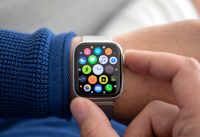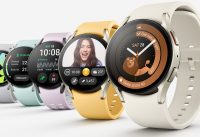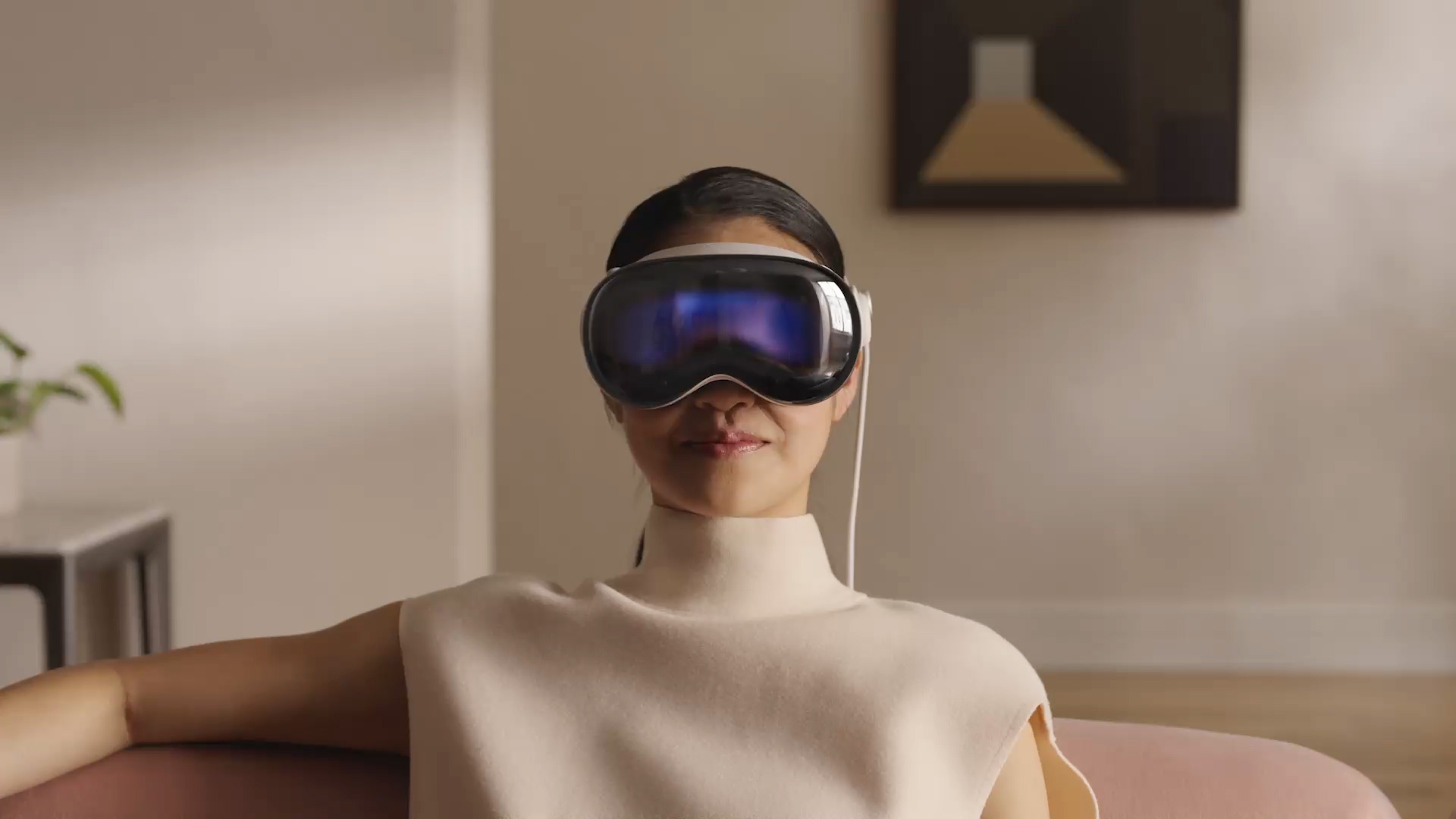Apple Vision Pro: A New Frontier in Augmented Reality
Apple’s latest innovation, the Vision Pro, has garnered significant attention as it marks the company’s entry into the world of wearable computer devices. Priced at $3,499 and hailed as a pioneer in “spatial computing,” the Vision Pro promises a new era of running applications seamlessly in your surroundings, essentially augmenting reality.
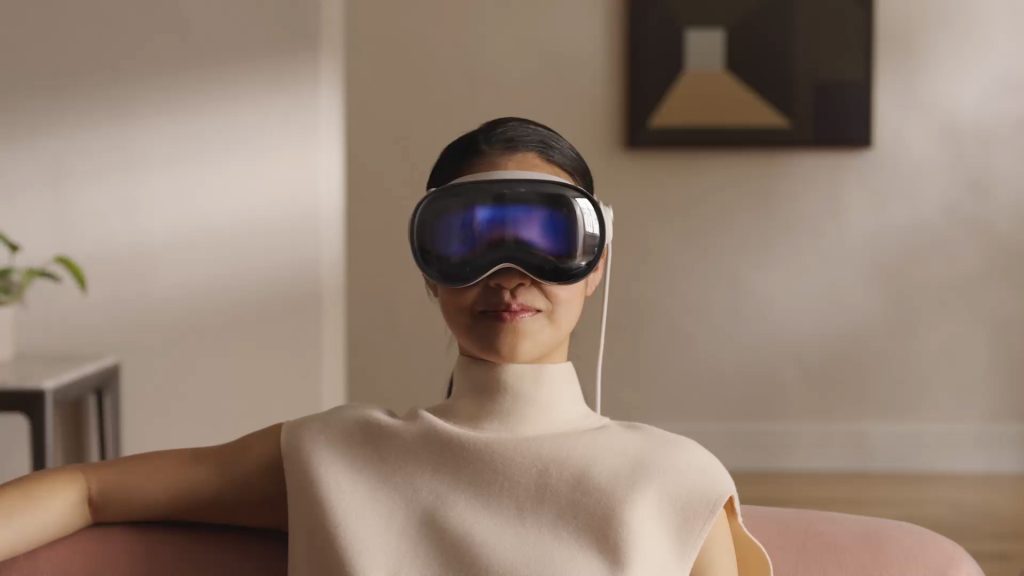
Apple’s promotional materials depict people integrating the Vision Pro into their daily lives, whether at work, doing household chores, or spending time with their children. The company’s ambition is nothing short of layering apps and information over the real world to create an immersive augmented reality experience.
However, Apple’s claim of pioneering spatial computing comes in a landscape where headset computers have been in development for over a decade. I still vividly remember trying out the first Oculus Rift development prototype back in 2013, and my colleague at The Verge, Adi Robertson, has had hands-on experience with virtually every headset released since then. This extensive development history has led to the creation of some impressive products, such as Meta’s Quest 3, a robust VR headset with an extensive game library and its own AR capabilities, available at a reasonable price of $500.
Apple has long emphasized the value of augmented reality over virtual reality, with CEO Tim Cook championing AR technology. The groundwork for AR has been laid for some time, with developers having access to AR tools in iOS, and higher-end iPhones and iPads equipped with lidar depth scanners. The Vision Pro represents Apple’s first foray into synthesizing these ideas, aiming to create a comprehensive device that seamlessly integrates into Apple’s ecosystem. It is designed not only for work, enabling the use of productivity tools like Excel, Webex, and Slack but also for entertainment, offering a virtual 4K HDR display and the ability to mirror a Mac’s screen, creating a massive virtual monitor in your field of view.
While the Vision Pro’s potential seems extraordinary, it also presents several substantial trade-offs that are hard to ignore. Some of these trade-offs are tangible, such as the weight of the device necessitating an external battery pack connected via a cable. Others are more philosophical in nature, raising questions about the willingness to sacrifice personal comfort and interaction with the real world for the allure of a computer-mediated experience.
During my time testing the Vision Pro, I found myself pondering these questions:
- Is the Vision Pro’s performance so exceptional that I am willing to compromise my appearance every time I wear it?
- Is it so impressive that I would choose to carry it in its bulky case instead of a conventional laptop bag?
- Does it genuinely enhance my experience enough to prefer viewing the world through screens rather than my natural vision?
While the Vision Pro undoubtedly presents a compelling case for augmented reality, there is still a long journey ahead before it can outshine the real world.
Hardware and Design
Despite Apple’s efforts to distinguish the Vision Pro from VR headsets, it shares some similarities with VR technology. When you put it on, it completely obstructs your view and replaces it with a 3D video feed of your surroundings, thanks to front-facing cameras. However, it can also immerse you in virtual reality experiences of varying depth, allowing you to work on the Moon or have windows floating in your kitchen.
Defining the terminology can be tricky in the realm of head-mounted displays, with terms like augmented reality, mixed reality, and virtual reality often used interchangeably. To clarify:
- Augmented Reality (AR): Involves virtual projections directly related to physical objects, like translating a restaurant menu or displaying a virtual poster on a real wall.
- Mixed Reality (MR): Combines virtual and physical elements without direct interaction, such as having an app window floating in your living room.
- Virtual Reality (VR): Immerses users entirely in a virtual environment, disconnecting them from the physical world.
The Vision Pro stands out compared to traditional VR headsets, boasting a sleek design crafted from magnesium, carbon fiber, and aluminum, seamlessly blending with Apple’s design language. Its compact form surprises many, given the bulky VR headsets of the past decade.
However, the front display, meant to maintain a connection with the outside world, falls short of expectations. While Apple’s marketing portrays it as a bright screen displaying your eyes to those around you (dubbed EyeSight), in reality, it is a low-resolution OLED with a lenticular panel that offers a minimal 3D effect. It struggles to be visible in well-lit environments and creates an uncanny, ghostly image of your eyes, making genuine eye contact a far-fetched idea. Moreover, there are no controls or indicators in visionOS to gauge what others see, leading to an awkward disconnect during conversations.
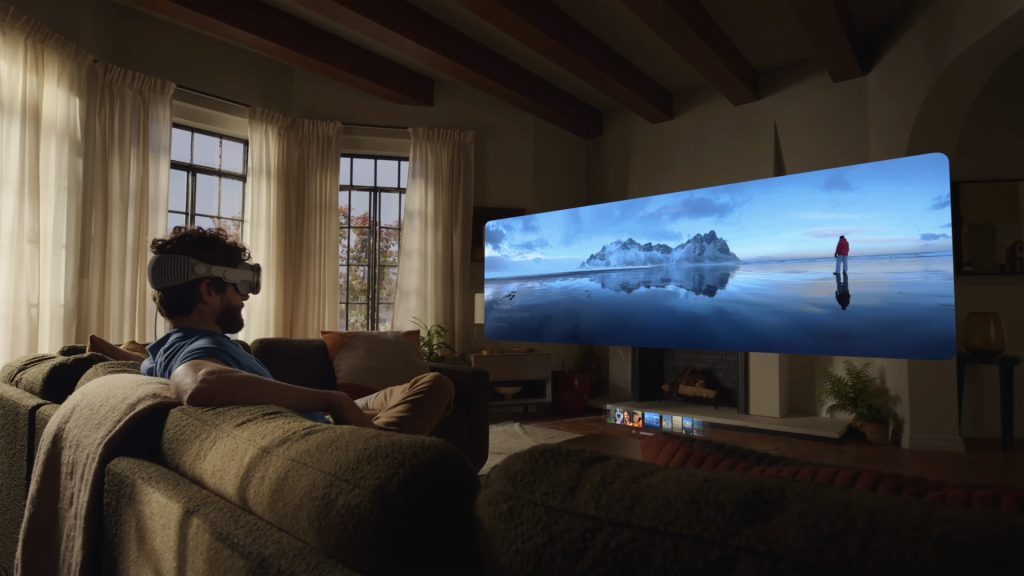
Behind the cover glass lies an array of cameras, sensors, and technology, including high-resolution front cameras for video passthrough, hand-tracking cameras, a lidar scanner, TrueDepth cameras for spatial tracking, and infrared floodlights for low-light functionality. The device is powered by an M2 processor, Apple’s R1 spatial coprocessor, and a pair of fans to dissipate heat generated by the extensive technology. While the fans operate quietly, the headset can become noticeably warm during extended use.
At the top edge of the device, you’ll find familiar Apple Watch-inspired controls: a digital crown for adjusting volume and virtual reality immersion levels on the right side and a button on the left for capturing 3D photos and videos.
The Vision Pro includes two headbands: the solo knit band and the dual loop band. Both are easy to attach and detach, but the solo band is preferred for its comfort and minimal impact on hairstyle. Additionally, the device offers customization options for users with glasses, allowing them to insert custom Zeiss lens inserts for a comfortable experience.
The Vision Pro’s speakers are integrated into the side arms and deliver impressive, immersive spatial audio. However, they can be quite loud and may disturb those nearby, unless you opt for headphones. While any Bluetooth headphones are compatible, the latest AirPods Pro offers enhanced features like lower latency, lossless 48KHz audio, and Apple’s Adaptive Audio system, which incorporates real-world sounds seamlessly.
The most noticeable aspect of the Vision Pro’s hardware is its weight, a consequence of packing extensive technology into a wearable device. Depending on the chosen band and light seal, the headset alone weighs between 600 and 650 grams, making it bulkier than an 11-inch iPad Pro and nearly as heavy as a 12.9-inch iPad Pro. Unlike some other headsets that balance weight with elaborate headbands, the Vision Pro places the bulk of its weight on the front, making extended use uncomfortable over time.
Notably, the Vision Pro is significantly heavier than competitors like the Quest 2 and Quest 3, both of which have built-in batteries. Apple’s decision to use an external battery was intended to reduce the headset’s weight. The battery itself, though unremarkable, connects securely to the headset with a twist connector. However, the attached braided cable is not detachable, and additional batteries are available for $199 but cannot be hot-swapped.
Setting up the Vision Pro is straightforward, with minimal manual adjustments required. The device employs motorized and sensor-driven mechanisms, eliminating the need for a cumbersome

